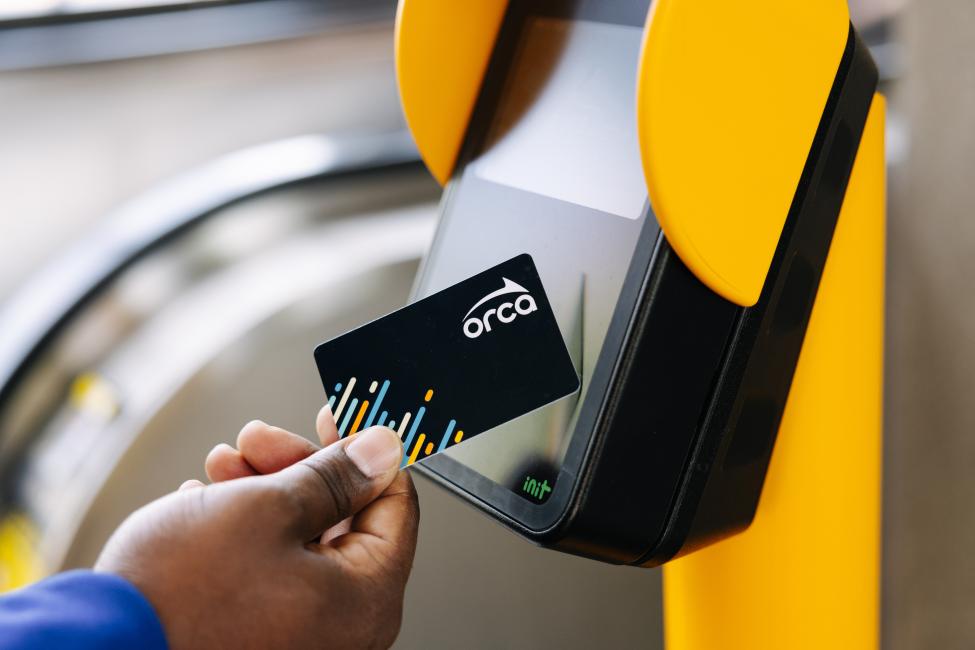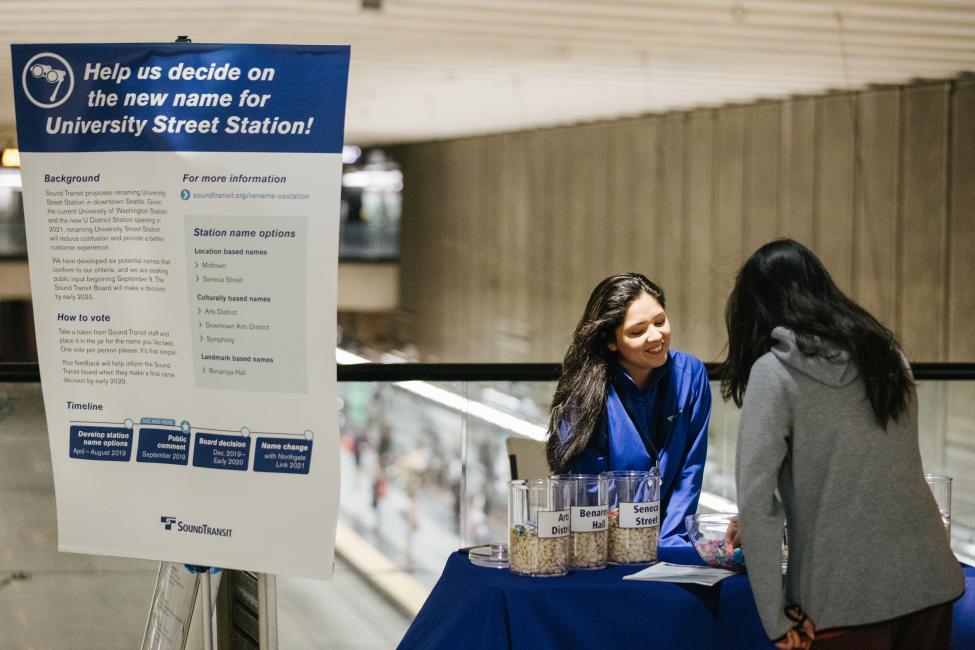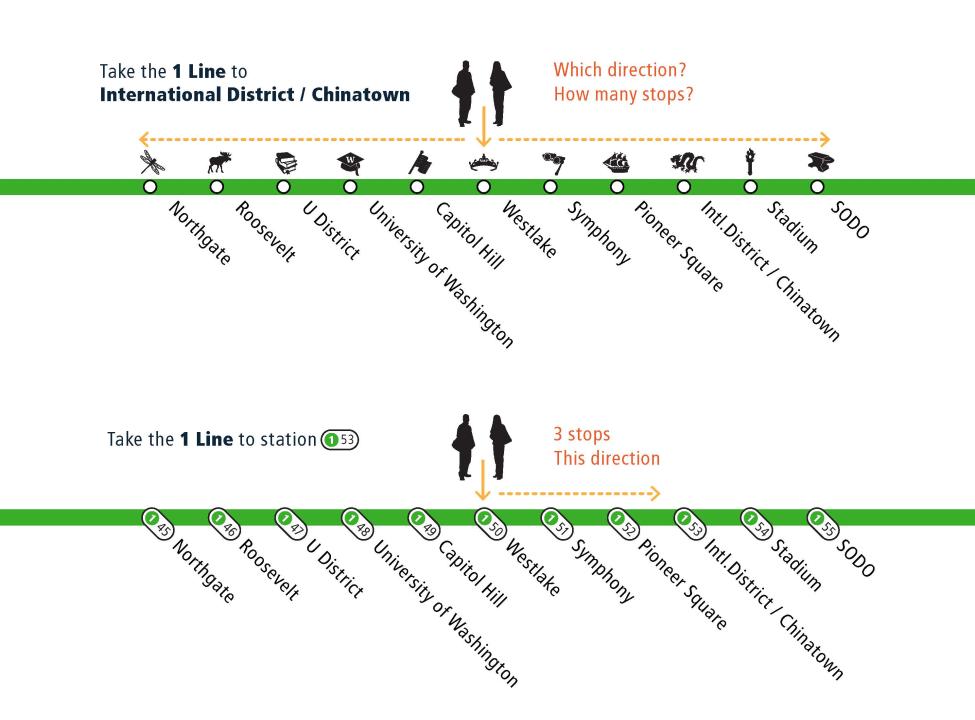Along with the opening of 1 Line service to Lynnwood City Center, several upcoming changes will enhance your ride on Link light rail. As we continue to evolve and improve our services, we aim to make your journey more convenient, enjoyable, and straightforward.
Here’s what you need to know about three important changes coming August 30:
New $3 adult one-way Link light rail fare.
Newly renamed Symphony Station, formerly University Street Station.
Introduction of three-digit station codes for wayfinding.
$3 flat fare: Just tap before you board!
Beginning August 30, an adult one-way trip on Link light rail will be $3 flat. From then on, you only need to tap your ORCA card before you board—just tap the yellow card reader once you arrive at your closest Link station and enjoy your trip. This change is designed to simplify our fare structure, making it easier for you to plan and budget for your travels on Link. Whether you’re commuting to work, catching a flight at Sea-Tac, heading to a game, or getting dinner with friends, your trip on Link light rail will just be $3. One-way fares for the T Line in Tacoma will remain $2.
In Washington, all youth 18 and under ride transit for free. Reduced $1 fares for seniors and other specific groups are available now. Visit info.myORCA.com/using-orca/ways-to-save to see if you qualify.
Find the right ORCA for Business workplace transit benefits program for your business or organization: https://info.myorca.com/business-programs/.
Why we're looking at fare changes now
Sound Transit’s last fare change for Link light rail happened in 2015. While we’d planned to adjust fares in 2020, the pandemic led us to postpone any changes to better support our community during that challenging time. As our system continues to expand, we need to update our fare structure to ensure sustainable and high-quality service.
Link light rail fares are a crucial source of revenue for Sound Transit, helping us expand our transit services and maintain high-quality operations. Alongside fare revenue, we also rely on sales tax, government grants, property taxes, and motor vehicle excise taxes (MVET) to support our projects. Since it’s been eight years since our last fare increase and the economic landscape keeps evolving, we need to adjust fares to meet our current financial needs and keep our commitments to the region.
Distance-based vs. flat fare considerations
Currently, Link light rail uses a distance-based fare system, where fares depend on how far a passenger travels. This system requires passengers to tap on when they board and tap off when they exit the train. If passengers forget to tap off, they are charged the highest fare from their originating station. While this method adjusts fares and charges riders only for the distance traveled, it can be confusing and inconvenient.
In response to input from Board members and the community, we're exploring a flat fare structure. Beginning August 30, there will be one $3 flat fare for all adult riders, making it simpler for passengers to understand and budget for their trips. This structure will only require passengers to tap on when they board, eliminating the need to tap off. Additionally, a flat fare could simplify future transitions to fare capping, where there is a maximum amount a rider can be charged in a given period, promoting fairness and ease of use.
Fare Ambassadors check ORCA cards for proof of fare payment on Sounder, 1 Line, 2 Line, and T Line trains. Working in pairs, they start at opposite ends of light rail vehicles and announce their presence before checking for paid fares. On Sounder, they inspect both decks. Have your proof of paid fare ready, and feel free to ask any questions. As we implement these changes, our goal is to create a fare system that balances simplicity, fairness, and financial sustainability. We value your input and look forward to continuing to provide a transit system that meets the needs of our growing community.
University Street Station becomes Symphony Station
As part of our ongoing efforts to enhance our rider experience, University Street Station will be renamed Symphony Station. This new name celebrates the nearby Seattle Symphony and reduces confusion, since riders often (understandably) confused University Street Station with University of Washington Station and U District Station.
In 2019, Sound Transit asked the public to weigh in on the renaming. We received over 14,000 responses on a systemwide survey, including more than 13,300 online responses and over 800 in-person survey responses. The results showed that Symphony Station received the highest number of votes from the public, compared with “Benaroya Hall Station,” “Seneca Street Station,” “Midtown Station,” “Downtown Arts District Station,” and “Arts District Station.” In October 2021, the Sound Transit Board authorized the renaming of the station.
The name change to Symphony Station will take effect August 30 and will provide clearer wayfinding, helping visitors and residents alike locate nearby attractions more easily. Look out for new signs and maps showing Symphony Station this summer!
Three-digit station codes for better wayfinding
Sound Transit is committed to ensuring that our services are accessible and easy to navigate for all our riders. As we continue to expand our Link light rail system, we are making some changes to our Link station naming system to improve the way you experience our transit network. Starting August 30, we will be replacing our unique Link station pictograms with three-digit station codes.
Why the change?
Washington state law requires us to have station identifiers not based on the Roman alphabet to better assist Limited English Proficiency (LEP) passengers, visitors, and riders with disabilities. For many years, our Link stations have been accompanied by small pictograms — graphical symbols representing nearby landmarks or neighborhood identifiers. For example, Capitol Hill Station had a Pride flag and SODO Station had an anvil. While these pictograms have served us well, they have become increasingly difficult to adapt as we prepare for more Link expansions in the coming years. Furthermore, they were not widely used — less than 20% of surveyed riders used them for navigation. To address this challenge, we recognized the need for an upgrade that would better support our growing transit system.
Why we chose station codes
Station codes are an international best practice. Urban metro systems in cities like Tokyo, Seoul, and Singapore have successfully implemented three-digit codes as an alternate station ID system. Station codes transcend language barriers in transit system navigation. Arabic numerals, unlike pictograms, are more globally recognized and widely used, making them more accessible to a diverse population of residents and tourists alike.
The new three-digit station codes ensure improved assistance for LEP populations and visitors; by using a numerical system, we can offer clearer and more straightforward wayfinding for those who may struggle with language barriers. The focus of the new codes is on wayfinding over local branding; while the old pictograms emphasized local landmarks or symbols, the new codes prioritize easy navigation and understanding of our transit network. The station codes also offer a clear indication of station locations, showing the number of stops at each station, which makes it easier for some riders to plan their journeys. Lastly, the new system allows for easy upgrades as our Link light rail system continues to grow, ensuring consistency across both current and future Link extensions.
How we developed our station codes
Developing our new station code system was a thorough and thoughtful process. In 2022, we conducted extensive testing with LEP groups to ensure the new system meets their needs. We then gained approval from the Ridership Experience and Operations (REO) Committee after extensive evaluation. In 2024, we stress-tested our numbering system and conducted a cultural review to avoid any negative associations, such as tetraphobia (fear of the number four) and other number-related superstitions.
We also looked at best practices from metro systems in Asia to inform our design through peer review. Additionally, we tested our current pictogram model against other numbering systems using six focus groups in five different languages to ensure our new system is effective and user-friendly. 58% of survey participants said three-digit station codes would be helpful, and 58% of participants said the current pictograms were not helpful.
Preparing for the future
We have designed our new system to accommodate future expansions. Starting with "50" at Westlake, our centermost station, each station will have a new two-digit stop code paired with the lines that service it. For example, Westlake is the midpoint at 50 and will be designated as 1-50 in August. Once we connect the 2 Line, it will also be stop 2-50. We have reserved numbers for potential mid-line stations, ensuring our system remains adaptable as we continue to grow.
While many riders might not use these codes daily, for those who need them, they represent a significant leap forward in making our transit network easier to understand and use. We are excited about this upgrade and believe it will enhance your experience with Sound Transit. Thank you for riding with us and being part of our journey toward a more accessible and user-friendly transit system.
Want to share your thoughts?
We value your input. Let us know how these changes affect your travel experience, and please share any suggestions you might have for future service changes. Email your comments to servicechanges@soundtransit.org.
At Sound Transit, we’re dedicated to providing you with a reliable, efficient, and enjoyable transit experience. These upcoming changes are part of our ongoing efforts to enhance the way you travel around our beautiful region. Thank you for riding with us!



